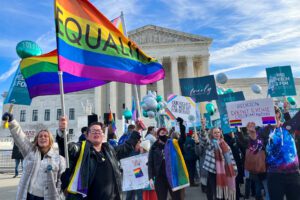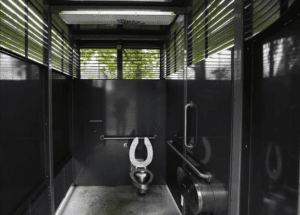 The United States lacks public restrooms. It’s a problem you might only notice when you need to go. Those with chronic conditions such as gastrointestinal disorders, parents with young kids, and older Americans with weaker bladders may be most affected by this shortage, though anyone who just drank a large iced coffee can find themselves in need of—and struggling to find—a bathroom.
The United States lacks public restrooms. It’s a problem you might only notice when you need to go. Those with chronic conditions such as gastrointestinal disorders, parents with young kids, and older Americans with weaker bladders may be most affected by this shortage, though anyone who just drank a large iced coffee can find themselves in need of—and struggling to find—a bathroom.
A 2021 report by QS Bathrooms Supplies, a United Kingdom-based bathroom retailer, found that the United States had only eight public restrooms per 100,000 people.1 These are typically located in parks, by public transit, or in publicly accessible buildings, though they can be tough to find in times of emergency. Some people have taken it upon themselves to scope out and share locations of public toilets, like Theodora Siegel, who created a TikTok account that posts videos about free public bathrooms in New York City.2 She’s even crowdsourced an interactive Google Map with all the locations.3
The lack of public restrooms means that the responsibility often falls to private businesses. When asked in 2002 about building more public restrooms, then-New York City Mayor Michael Bloomberg replied, “Why? There’s enough Starbucks that’ll let you use the bathroom.”4 Though businesses, hotels, libraries, and museums have stepped up with “open-bathroom” policies to provide this public service, people may still feel obligated—or be outright required to—purchase a product or service to gain access to a toilet.5 And depending on the hours of operation, these bathrooms may not be available at certain times of day.
Public Toilets in the Past
America’s standalone public toilets date back to colonial times, when buildings had no indoor plumbing or dedicated “bathrooms” like the ones we’re used to. According to Debbie Miller, who serves as a museum curator at Independence National Historical Park in Philadelphia, these public toilets were “common and generally communal” across the colonies; there was even an “octagonal outdoor toilet” located behind Independence Hall.6
At the turn of the 20th century, leaders of the temperance movement successfully advocated for the creation of public restrooms outside saloons in the hope that they would lead men to consume less alcohol in bars that had bathrooms.7 Throughout the Great Depression, President Franklin Delano Roosevelt’s New Deal public works programs built over two million “sanitary privies” in parks and “comfort stations” in cities across the country.8 By the 1970s, there were over 50,000 coin-operated pay toilets in America’s urban centers.9
The rise of the automobile and decline of downtown led to the closure of many public restrooms in train stations, bus terminals, and commercial districts.10 The New York City subway had 1,676 public restrooms available in the 1940s; by 2022, that number was down to a mere 78.11 Costly upkeep and strained budgets led to the removal of many public restrooms in subsequent decades, as toilets fell victim to vandalism and neglect.12 They were seen as dark and dirty, unsanitary and unsafe.
Private and Public Solutions
Public restrooms can cost anywhere from $80,000 to $500,000 to construct, and they require daily maintenance to keep them clean and functioning.13 Chad Kaufman, president of the Public Restroom Company which manufactures restrooms, notes that while cities “might have grant funds or public funds to build things, they typically don’t have operational funds to maintain these things.”14 The often glacial pace of government action means that it could take years to select a location, approve a plan, and design and construct the facilities.
The Council of the District of Columbia in 2017 passed the Public Restroom Facilities Installation and Promotion Act, which required a number of agencies to select sites and install public restrooms.15 It also required the mayor to “establish a financial incentive program to encourage private businesses to make their restrooms available to the public for free.”16 This sort of private-public partnership has been implemented in other countries like Germany and England, where local governments pay businesses a small stipend to promote their free toilets.17
In 2008, the city of Portland, Oregon, collaborated with a private manufacturer to design and install 24-hour, single-occupancy bathrooms called the “Portland Loo.”18 They have since been installed in dozens of other cities across the United States and Canada. China’s government led a directive, dubbed the “Toilet Revolution,” which constructed nearly 70,000 publicly accessible toilets in just two years.19 And in Tokyo, restrooms are designed to be vibrant works of art with bright colors, sleek designs, and “smart glass” that provides transparency and turns opaque when occupied.20
Prioritizing Public Restrooms
From a public health perspective, sanitation is crucial to well-being. An individual’s health contributes to the health of the community and the greater common good. When businesses were shuttered during the COVID-19 pandemic, we saw just how vital their bathrooms were to the public. When people don’t have access to a toilet—or a sink to wash their hands—germs and illnesses spread. Bathrooms also keep the surrounding areas of a community clean. They guarantee dignity to people who must meet their basic bodily needs. It can be humiliating to need the bathroom and not be able to go. People might risk arrest for public urination or end up soiling themselves because they couldn’t find one in time.
America’s restrooms should be easy to find, easy to use, safe, and comfortable. As communities improve their public spaces and upgrade their infrastructure, they should consider solutions that make sure their restrooms are accessible to all—regardless of disability, gender, gender identity, age, or socioeconomic status.
Discussion Questions
- Does your community have public bathrooms? If so, where are they located?
- Are there businesses in your community that have “open-bathroom” policies?
- Should creating more public bathrooms be a priority for communities?
- Do you think the lack of public restrooms is something the government, businesses, or both entities should address?
- If you think it is a government responsibility, which level or levels of government (local/state/national) would best address it?
As always, we encourage you to join the discussion with your comments or questions below.
Sources
Featured Image Credit: Alan Berner / Seattle Times
[1] New York Times: https://www.nytimes.com/2023/03/22/business/public-restrooms-bathrooms-us-city.html
[2] New York Times: https://www.nytimes.com/2023/01/15/opinion/new-york-public-toilets.html
[3] Ibid.
[4] CNN: https://www.cnn.com/2022/07/21/business/starbucks-bathrooms-stores-closing/index.html
[5] Ibid.
[6] New York Times: https://www.nytimes.com/2023/03/22/business/public-restrooms-bathrooms-us-city.html
[7] The Hustle: https://thehustle.co/the-fight-to-build-more-public-bathrooms-in-america/
[8] Bloomberg: https://www.bloomberg.com/news/features/2021-11-05/why-american-cities-lost-their-public-bathrooms
[9] Ibid.
[10] Ibid.
[11] The Hustle: https://thehustle.co/the-fight-to-build-more-public-bathrooms-in-america/
[12] New York Times: https://www.nytimes.com/2023/03/22/business/public-restrooms-bathrooms-us-city.html
[13] The Hustle: https://thehustle.co/the-fight-to-build-more-public-bathrooms-in-america/
[14] Ibid.
[15] DC Council: https://lims.dccouncil.gov/Legislation/B22-0223
[16] Ibid.
[17] Bloomberg: https://www.bloomberg.com/news/articles/2022-10-05/how-to-solve-the-great-urban-restroom-shortage
[18] Portland Loo: https://portlandloo.com/the-loo/
[19] New York Times: https://www.nytimes.com/2023/03/22/business/public-restrooms-bathrooms-us-city.html
[20] New York Times: https://www.nytimes.com/2020/08/19/world/asia/japan-transparent-toilets.html
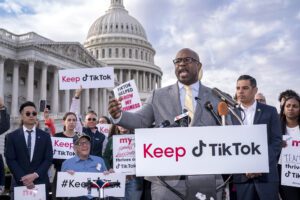
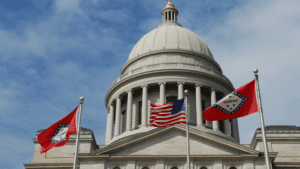 On March 6, Arkansas Governor Sarah Huckabee Sanders signed into law the Youth Hiring Act, a law that, among other things, allows children between the ages of nine and 16 to be hired without the need for an employment certificate to be filed with the state. Under previous state law, an employment certificate was required to be filed with the state providing proof of age, the work schedule and description, and the consent of the child’s parent or guardian.1 In the past few months, lawmakers in Iowa and Ohio have also proposed legislation that would reduce requirements for youth seeking work.2
On March 6, Arkansas Governor Sarah Huckabee Sanders signed into law the Youth Hiring Act, a law that, among other things, allows children between the ages of nine and 16 to be hired without the need for an employment certificate to be filed with the state. Under previous state law, an employment certificate was required to be filed with the state providing proof of age, the work schedule and description, and the consent of the child’s parent or guardian.1 In the past few months, lawmakers in Iowa and Ohio have also proposed legislation that would reduce requirements for youth seeking work.2 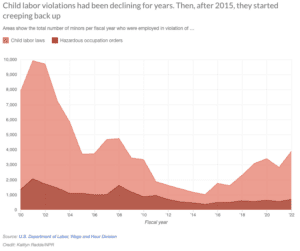 On February 27, two days after the New York Times report, President Joe Biden’s administration unveiled several policies that will be implemented to address the nearly 70 percent rise in child labor violations that has taken place from 2018-2022.11 The plan includes the creation of a new task force, targeting industries that have a history of violations, and advocating for heavier penalties and more funding for oversight.12 Congressional Democrats largely support the White House proposal. Republicans, meanwhile, say the Department of Health and Human Services is to blame for the child labor crisis because the Biden administration has loosened regulations regarding the support of migrant children.13 One third of migrant children who have been recorded by HHS now cannot be reached by government officials.14 Meanwhile, some states, such as Nebraska, have renewed their support for child labor protections. On January 5, Nebraska State Senator Carol Blood proposed a resolution that would make Nebraska the 29th state to ratify the Child Labor Amendment of 1924, an amendment to the Constitution that, if passed, would specifically allow Congress to regulate the labor of minors.15 Discussion Questions
On February 27, two days after the New York Times report, President Joe Biden’s administration unveiled several policies that will be implemented to address the nearly 70 percent rise in child labor violations that has taken place from 2018-2022.11 The plan includes the creation of a new task force, targeting industries that have a history of violations, and advocating for heavier penalties and more funding for oversight.12 Congressional Democrats largely support the White House proposal. Republicans, meanwhile, say the Department of Health and Human Services is to blame for the child labor crisis because the Biden administration has loosened regulations regarding the support of migrant children.13 One third of migrant children who have been recorded by HHS now cannot be reached by government officials.14 Meanwhile, some states, such as Nebraska, have renewed their support for child labor protections. On January 5, Nebraska State Senator Carol Blood proposed a resolution that would make Nebraska the 29th state to ratify the Child Labor Amendment of 1924, an amendment to the Constitution that, if passed, would specifically allow Congress to regulate the labor of minors.15 Discussion Questions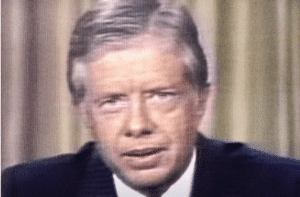 On February 18, the Carter Center released a statement saying that former President Jimmy Carter had opted to spend “his remaining time at home” following a number of hospital stays and declining health.1 News of the 98-year-old former president’s condition has brought an outpouring of support and renewed attention to his life and legacy as the 39th president of the United States. President Carter’s “Crisis of Confidence” speech is perhaps his most famous, and its words are still relevant for our country today.2
On February 18, the Carter Center released a statement saying that former President Jimmy Carter had opted to spend “his remaining time at home” following a number of hospital stays and declining health.1 News of the 98-year-old former president’s condition has brought an outpouring of support and renewed attention to his life and legacy as the 39th president of the United States. President Carter’s “Crisis of Confidence” speech is perhaps his most famous, and its words are still relevant for our country today.2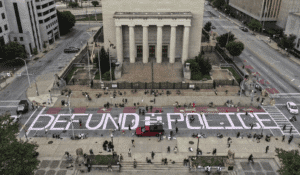 Following the 2020 murder of George Floyd by Minneapolis police officer Derek Chauvin, a call by activists to “defund the police” achieved national attention. Supporters of defunding the police have argued that—at least some of—the billions of dollars spent on policing each year could be better used by investing in educational, recreational, and mental health programs, among others, in an effort to reduce crime and increase community well-being more generally. With the release of footage showing multiple officers pepper-spraying, kicking, and punching Tyre Nichols—leading to his death three days later—questions of whether and how to reduce police budgets have been brought back into the national conversation.1
Following the 2020 murder of George Floyd by Minneapolis police officer Derek Chauvin, a call by activists to “defund the police” achieved national attention. Supporters of defunding the police have argued that—at least some of—the billions of dollars spent on policing each year could be better used by investing in educational, recreational, and mental health programs, among others, in an effort to reduce crime and increase community well-being more generally. With the release of footage showing multiple officers pepper-spraying, kicking, and punching Tyre Nichols—leading to his death three days later—questions of whether and how to reduce police budgets have been brought back into the national conversation.1 This is what many activists mean when they call for the police to be defunded. Reduce the number of responsibilities we ask of the police, decrease police budgets to match the reduced size of the police force, and use the diverted funds to invest in programs and staff who are trained to address mental health crises, struggling schools, and other social issues.
This is what many activists mean when they call for the police to be defunded. Reduce the number of responsibilities we ask of the police, decrease police budgets to match the reduced size of the police force, and use the diverted funds to invest in programs and staff who are trained to address mental health crises, struggling schools, and other social issues.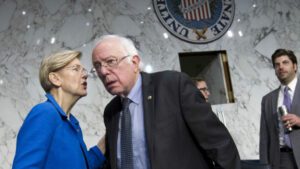
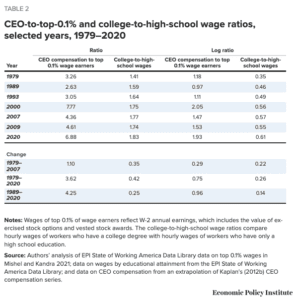
 The handling of sensitive information has become a headline-grabbing issue in recent months owed to the discovery of classified documents at the homes and offices of former President Donald Trump, President Joe Biden, and former Vice President Mike Pence. The political consequences of any judgment of wrongdoing on behalf of former President Trump, President Biden, and/or former Vice President Pence have introduced significant controversy into the national discussion of this issue. In light of this controversy, Attorney General Merrick Garland has established a special prosecutor for the Trump and Biden cases, who will work independently of the Department of Justice to determine whether any criminal conduct took place. Although a special prosecutor has not yet been appointed to investigate the Pence case, many experts see this as highly likely.1
The handling of sensitive information has become a headline-grabbing issue in recent months owed to the discovery of classified documents at the homes and offices of former President Donald Trump, President Joe Biden, and former Vice President Mike Pence. The political consequences of any judgment of wrongdoing on behalf of former President Trump, President Biden, and/or former Vice President Pence have introduced significant controversy into the national discussion of this issue. In light of this controversy, Attorney General Merrick Garland has established a special prosecutor for the Trump and Biden cases, who will work independently of the Department of Justice to determine whether any criminal conduct took place. Although a special prosecutor has not yet been appointed to investigate the Pence case, many experts see this as highly likely.1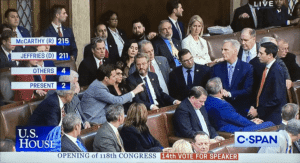 When the 118th Congress convened on January 3, what is usually a quick procedural vote for speaker turned into a contentious five days of voting on the floor of the House of Representatives.1 The frustrations, negotiations, and heated debates were on display on C-SPAN. Since the House could not adopt rules without a speaker—members-elect could not even take their oaths of office—C-SPAN cameras had a period of unprecedented access to roam the chamber, using three cameras to broadcast the proceedings without the usual constraints of House rules.
When the 118th Congress convened on January 3, what is usually a quick procedural vote for speaker turned into a contentious five days of voting on the floor of the House of Representatives.1 The frustrations, negotiations, and heated debates were on display on C-SPAN. Since the House could not adopt rules without a speaker—members-elect could not even take their oaths of office—C-SPAN cameras had a period of unprecedented access to roam the chamber, using three cameras to broadcast the proceedings without the usual constraints of House rules.
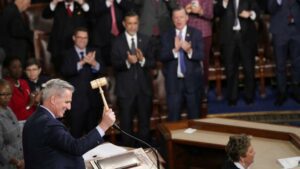 An under-the-radar rule change proposed by Democrats in the House of Representatives in the waning days of 117th Congress could potentially increase members’ yearly compensation. The provision, approved by the House Administration Committee, would allow reimbursement for a number of living expenses, including lodging, food, and travel in Washington, D.C.
An under-the-radar rule change proposed by Democrats in the House of Representatives in the waning days of 117th Congress could potentially increase members’ yearly compensation. The provision, approved by the House Administration Committee, would allow reimbursement for a number of living expenses, including lodging, food, and travel in Washington, D.C.